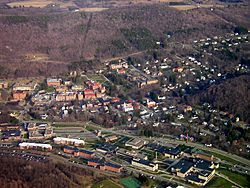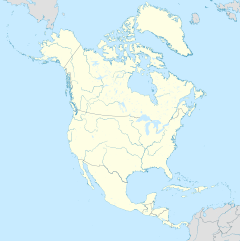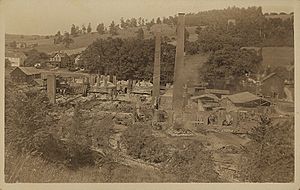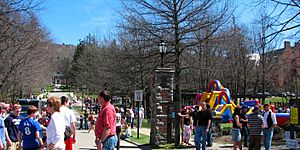Alfred (village), New York facts for kids
Quick facts for kids
Alfred, New York
|
|
|---|---|
|
Village
|
|

Aerial view of Alfred village, taken April 2006. Alfred State College is near the bottom of the photo, and at the upper-middle is Alfred University.
|
|
| Country | United States |
| State | New York |
| County | Allegany |
| Town | Alfred |
| First settled | 1807 |
| Incorporated (Village) | 1881 |
| Area | |
| • Total | 1.19 sq mi (3.08 km2) |
| • Land | 1.19 sq mi (3.08 km2) |
| • Water | 0.00 sq mi (0.00 km2) |
| Elevation | 1,765 ft (538 m) |
| Population
(2020)
|
|
| • Total | 4,026 |
| • Density | 3,383.19/sq mi (1,306.43/km2) |
| Time zone | UTC-5 (Eastern (EST)) |
| • Summer (DST) | UTC-4 (EDT) |
| ZIP code |
14802
|
| Area code(s) | 607 |
| FIPS code | 36-01198 |
| GNIS feature ID | 0942313 |
Alfred is a small village in Allegany County, New York, United States. In 2020, about 4,026 people lived there.
Alfred is special because it's home to two colleges: Alfred University and Alfred State College. In fact, a newspaper called The Washington Post said in 2023 that Alfred was "the collegiest college town in America." This means it has a very high number of students compared to other residents.
Thanks to the New York State College of Ceramics, Alfred is also a major center for artists and engineers who work with clay and pottery.
Contents
History of Alfred
Early Settlement and Name
The land around Alfred was once home to the Seneca tribe. In 1807, three families who were Seventh Day Baptists moved to the area. These were the families of Clark Crandall, Nathan Green, and Edward Green. They were the first of many people from their religious group to settle in the village.
People often say that Alfred was named after Alfred the Great, a famous English king. However, no one has ever proven this for sure. For a long time, the village was known as Alfred Centre.
Alfred's Colleges and Civil War
In 1832, Alfred University was started in the village. This college was one of the first to allow both boys and girls to study together. It aimed to teach students useful skills as well as general knowledge. The university was seen as an important place for learning by the Seventh Day Baptists.
Alfred was also a strong supporter of the movement to end slavery. During the American Civil War, nearly 150 people from the village fought for the Union army.
Rise of Ceramics in Alfred
In 1888, the Celadon Terra Cotta Company was founded in Alfred. This happened after high-quality clay was found nearby. Over the next ten years, the company grew a lot. It became a top maker of roof tiles and decorative clay for buildings. Because of this company and another one called Alfred Clay Company, Alfred became known for ceramics. This led to the New York State College of Ceramics being built here in 1900.
20th Century Developments
The new ceramics college hired a British ceramic artist named Charles Fergus Binns. He believed that students should understand both the art and the science of ceramics. Under his guidance, the college became a leading school for studying ceramics. It even created separate programs for ceramic art and ceramic engineering. Even after the Celadon Terra Cotta Company's factory burned down in 1909, Alfred remained a key place for ceramics because of the college.
In 1908, an agricultural school was started at Alfred University. It had a farm, animals, and farm machines for students to learn about farming. Later, in 1937, a school for Engineering Technology was added. In 1948, this entire college separated from Alfred University to become Alfred State College.
From 1940 to 1957, a company called Glidden Pottery operated in Alfred. They made unique stoneware dishes with cool designs. These dishes were affordable and had a modern style. Today, they are popular items for collectors.
On April 30, 1972, the village held its first Hot Dog Day. Students from both Alfred University and Alfred State College organized this fun event together.
Historic Buildings in Alfred
Alfred has many old and important buildings. Several of them are listed on the National Register of Historic Places. These include:
- Alumni Hall
- Fireman's Hall
- Steinheim Castle
- Terra Cotta Building
Also, 55 buildings in Alfred's downtown area are part of the Alfred Village Historic District. This means they are protected because of their historical importance.
Geography and Landscape
Alfred is located in the hills of western New York. It is part of a hilly region called the Allegheny Plateau, which is part of the Appalachian Mountains.
The village covers about 3.1 square kilometers (1.19 square miles) of land. A small stream called Kanakadea Creek flows through the middle of the village. This creek eventually flows into the Canisteo River, which is part of the larger Susquehanna River system.
The village itself is in the lowest part of a valley. On the hills to the east and west are Alfred University and Alfred State College. Native Americans originally called this valley Kanakadea.
The elevation of Alfred is about 518 meters (1,700 feet) above sea level. However, it rises to a high point of 718 meters (2,355 feet) at the top of Jericho Hill, just south of the village. These hills greatly affect the weather, causing quick changes and different conditions in nearby valleys.
Population of Alfred
Alfred has a changing population, partly because of its colleges. Many students live in the village during the school year.
| Historical population | |||
|---|---|---|---|
| Census | Pop. | %± | |
| 1860 | 177 | — | |
| 1880 | 513 | — | |
| 1890 | 786 | 53.2% | |
| 1900 | 756 | −3.8% | |
| 1910 | 759 | 0.4% | |
| 1920 | 598 | −21.2% | |
| 1930 | 639 | 6.9% | |
| 1940 | 694 | 8.6% | |
| 1950 | 2,053 | 195.8% | |
| 1960 | 2,807 | 36.7% | |
| 1970 | 3,804 | 35.5% | |
| 1980 | 4,967 | 30.6% | |
| 1990 | 4,559 | −8.2% | |
| 2000 | 3,954 | −13.3% | |
| 2010 | 4,174 | 5.6% | |
| 2020 | 4,026 | −3.5% | |
| U.S. Decennial Census | |||
In 2000, there were 3,954 people living in Alfred. Most residents were White (90.21%). There were also people who identified as Black or African American (4.40%), Asian (2.71%), Native American (0.33%), and other races. About 2.73% of the population was Hispanic or Latino.
The average age in the village was 20 years old. This is very young because of all the college students. Most of the population (83.1%) was between 18 and 24 years old.
See also
 In Spanish: Alfred (villa) para niños
In Spanish: Alfred (villa) para niños







